Introduction
Imagine this: You have painstakingly honed your product descriptions, run advertisements, and fine-tuned your homepage over many weeks. Visitors are arriving in masses. They are clicking, exploring, adding products to their shopping cart, then poof, they are gone. No succession. No income. Only a full online shopping cart is left.
This is shopping cart abandonment, a major issue for e-commerce shopping cart experiences worldwide, especially for small and medium-sized businesses (SMEs). It is beyond a missed sale; it is a lost chance after the buyer has already said “maybe.” That near conversion, and still no activity? That stings.
The good news is that digital shopping cart abandonment is not the end of the narrative. Particularly if you know the specific Indian online consumer behavior, it is a fixable issue. Using the correct shopping cart optimization techniques, customized for the Indian market and affordable, you can transform abandoned carts into finished orders and increase your sales without the need for large funds.
We'll examine the reasons behind shopping cart abandonment in this blog, investigate India-specific problems, and find workable, tech-enabled shopping cart abandonment solutions that enable e-commerce businesses to recover clients and generate more sales.
This is shopping cart abandonment, a major issue for ecommerce shopping cart experiences worldwide. Modern ecommerce app development plays a vital role in optimizing the buying journey and reducing abandonment risks.
Understanding Shopping Cart Abandonment in Ecommerce
Fundamentally, shopping cart abandonment describes the situation whereby a buyer adds one or more items to their ecommerce shopping cart but leaves the site before finishing the purchase. Passive browsing differs from this; these users had genuine purchasing intentions.
Consider this: running a physical retail store wherein a customer loads their basket with items, heads to the check counter, and then just walks out without making a purchase. No talking. No sale.
Imagine that occurring hundreds or thousands of times every month; that is the scale of loss internet companies experience as a result of online shopping cart abandonment. The worst aspect? Many of these abandonment events are avoidable; they frequently result from events that go against customer expectations.
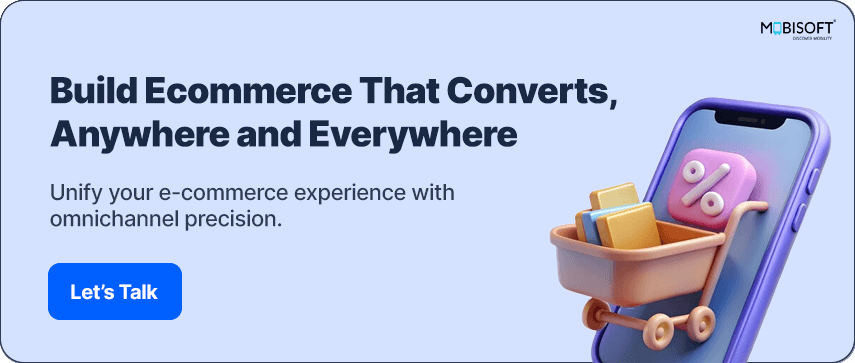
Why Does Shopping Cart Abandonment Matter for Online Stores?
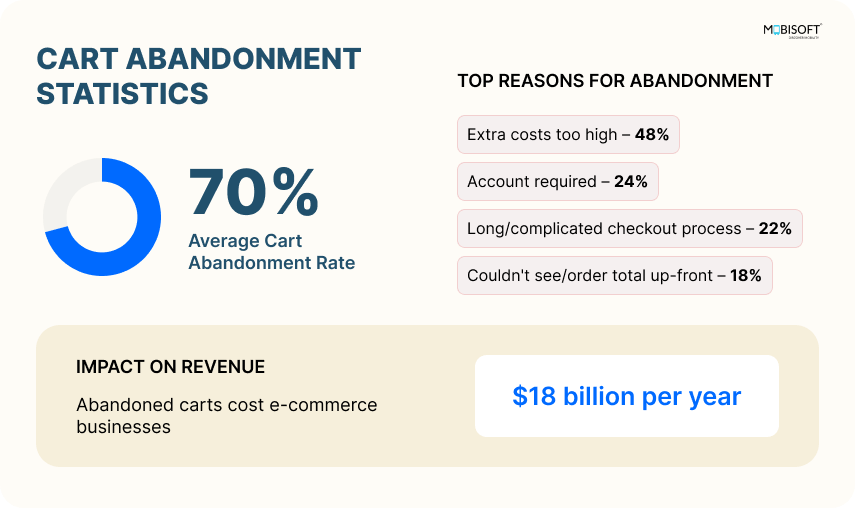
Every shopping cart left behind is lost income. Beyond the economic damage, though, there is still another cost: consumer trust and engagement. Cart abandonment by customers may indicate a bad user experience, shattered trust, or unsatisfied expectations at key points in the checkout process.
Shopping cart abandonment statistics also offer a special perspective on customer psychology. Because these consumers were almost ready to buy, even little changes in your shopping cart software, communication, or technology can significantly boost sales. Correcting it is a strategic step toward sustainable expansion rather than just a tactical victory.
Learn how monitoring your cart abandonment rate can help track and improve conversion outcomes.
Region-Specific Challenges Behind Digital Shopping Cart Abandonment
Different ecommerce markets throughout the world have varying shopping cart abandonment rates, sometimes reaching more than 70–80% in some product categories. These figures indicate thousands of transactions are lost every day.
Challenges range from technological infrastructure and payment choices to trust issues and user experience friction in several areas. Understanding and targeting the particular variables affecting consumers in various locations is crucial for reducing cart abandonment successfully.
Key Contributing Factors for Shopping Cart Abandonment
Internet Connectivity
In regions with unstable internet infrastructure, particularly in rural or underserved areas, consistent connectivity can be a hurdle, particularly in Tier 2/3 cities and rural areas. Users could start the checkout process only to experience interruptions, page timeouts, or a total loss of connectivity before finishing the order. These disturbances often lead to abandoned shopping carts and cause aggravation.
Real impact: A lagging payment gateway or a faulty page load can rapidly discourage consumers from completing the purchase.
Diverse Payment Preferences
Modern shoppers expect a range of payment methods for ecommerce, from digital wallets and local banking solutions to credit cards and cash on delivery (COD). If their preferred method isn’t available or the gateway malfunctions, they often abandon the purchase.
Many customers quit their transaction when their chosen payment option is not accessible or when the payment gateway fails to load during checkout. Among first-time buyers and rural consumers who rely on local wallets or COD to finish online shopping cart transactions, this is especially prevalent.
Mobile-First Behavior
In mobile commerce-dominant markets, where the majority of users browse on smartphones, a non-optimized checkout experience can significantly hurt conversions. Still, many ecommerce shopping cart sites are not well adapted for mobile consumption.
Buttons that are difficult to touch, complicated forms, tiny fonts, and slow-loading pages deter mobile users from finishing their purchases, particularly when using low-bandwidth connections or budget devices.
Language and Trust Barriers
In multilingual countries, checkout pages available only in one language can frustrate users. Additionally, first-time or skeptical shoppers look for clear trust signals, secure payment badges, visible customer reviews, and transparent return policies.
Particularly when consumers are unfamiliar with the brand, the lack of these components usually causes questions and reluctance or cart abandonment.
Surprise Costs at Checkout
Many consumers abandon shopping carts due to unforeseen delivery fees, extra taxes, or handling charges added at the last step. In price-sensitive markets, unexpected checkout costs can deter buyers.
Shoppers might compare prices across platforms or choose not to purchase at all if the ultimate amount varies considerably from what was initially shown.
Improving checkout performance depends on knowledge of these region-specific friction spots. Conversion happens naturally when you solve issues your audience feels.
Affordable Solutions for Reducing Shopping Cart Abandonment
Shopping cart abandonment is rarely down to a technical fault. It is much more likely to be the result of a poor ecommerce shopping cart experience, unclear communication, and/or a failure to meet customer expectations. The good news? It is possible to reduce shopping cart abandonment with smart, budget-friendly, easy-to-implement solutions that can improve conversion.
Now, let’s talk about cost-effective, impactful, and easy to implement. Businesses investing in custom ecommerce development often gain more control over the checkout experience, improving overall conversions.
Simplify the Checkout Process
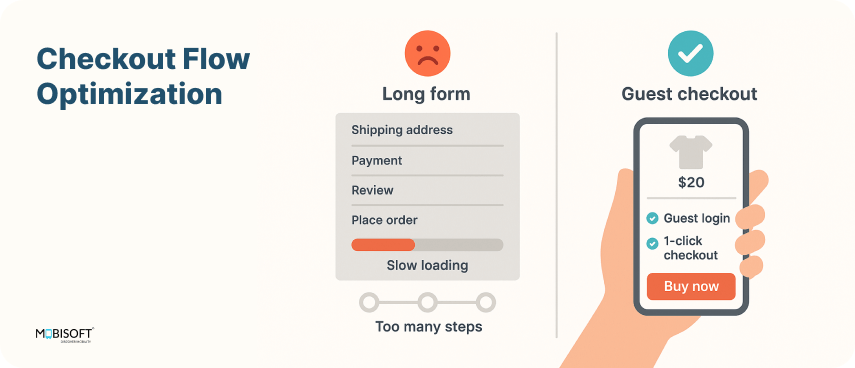
One of the main friction points in online shopping carts is a complicated or long checkout process. Faced with several forms, needless fields, or forced registrations, customers become impatient.
Minimize steps, ideally no more than 2–3 clicks to complete an order
Ideally, the checkout optimization should require only two to three clicks. Customers can use a progress bar to see how far along they are towards finalizing their purchase.
Offer guest checkout. Forcing account creation is a deal-breaker
For first-time shoppers or those in a rush, provide visitor checkout choices. Forcing account creation is a deal-breaker and a known cart abandonment strategy to avoid.
Make sure forms are clean and optimized for touch input on smaller screens
Make design forms precisely maintain cleanliness, prefill wherever feasible, utilize autodetection for city and pin codes, and make sure mobile touch input fields are optimized for ease of use.
Mobile-Friendly Optimization
An ecommerce shopping cart site must provide a great mobile experience, especially since a large percentage of consumers shop via mobile devices.
A responsive, mobile-first design is non-negotiable
Adopt a responsive design that automatically adapts to several screen sizes. Users should be guided easily through a simple and aesthetically pleasing arrangement.
Ensure Mobile-Friendly Form and UI Accessibility
Make sure buttons are simple to click, text is readable without pinch zooming, and input fields are correctly spaced.
Compress images and scripts to ensure fast loading speeds even on low bandwidth
By compressing photographs and optimizing code, one could help to speed up the page loading time. Cart abandonment can result from just a few seconds of delay, especially on lower-end cellphones or patchy networks found in Tier 2 and Tier 3 locations.
Cart abandonment can result from just a few seconds of delay. For a seamless customer journey across all touchpoints, check out our omnichannel ecommerce guide.
Offer Multiple Payment Options
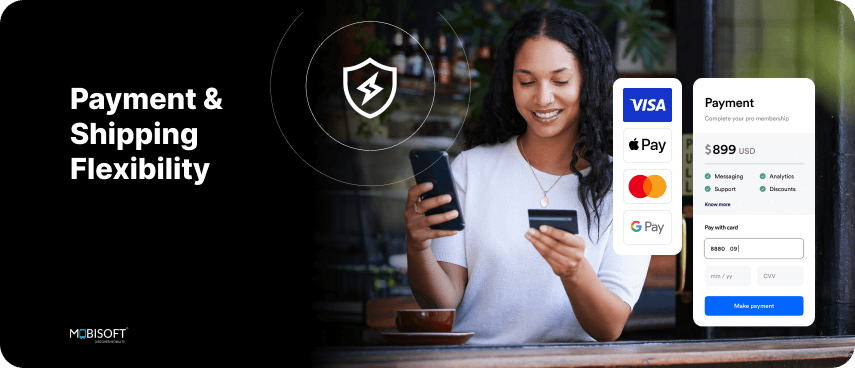
Payment flexibility is now expected. Customers may abandon their shopping cart if preferred payment options for ecommerce are missing.
UPI
Fast, trusted, and widely used.
Include regionally preferred instant payment systems that are fast, secure, and widely trusted.
Credit/Debit Cards
Support major networks like Visa, Mastercard, and RuPay.
Networks such as Visa, Mastercard, RuPay, and even international cards for NRI clients support credit and debit cards.
Digital Wallets
Support major digital wallets popular in your target market, whether it’s Apple Pay, Google Pay, local wallets, or others.
Cash on Delivery (COD)
Offer Cash on Delivery (COD) where relevant, especially for customers hesitant about digital payments.
Net Banking
To guarantee the broadest coverage, include net banking solutions from a broad spectrum of public and commercial institutions.
This helps improve the checkout experience while reducing digital shopping cart abandonment.
Be Transparent with All Costs
Nothing ruins a purchase quicker than unanticipated charges. Customers want transparency; when they don't get it, they leave their carts.
Show total cost upfront, including delivery and taxes
Include delivery expenses, taxes, or any convenience charges to show the entire pricing upfront. Before checkout, confirm this is visible on the cart summary or product page.
Avoid shocking customers at the final step with unexpected fees
Emphasize free shipping on a minimum cart value prominently to motivate higher order values.
If you offer free shipping thresholds, mention them early
Dynamic pricing systems that automatically update the total amount as consumers change their carts should be used.
Build Trust Instantly
Customers don’t convert when they sense a lack of credibility. First-time buyers, in particular, need assurance throughout the shopping cart journey.
Add security badges (e.g., SSL secure, PCI-compliant)
At every point of the checkout process, show trust signals like SSL certificates, secure payment badges, and platform compliance symbols.
Display ratings and testimonials right on the product and cart pages
Particularly for items with higher cart value, emphasize validated customer reviews. Include user-uploaded images and actual delivery comments when available.
Mention refund policies clearly; transparency builds credibility
Transparently convey return policies and refunds. When clients understand they can easily return an item if necessary, they are more likely to make a purchase.
Reducing cart abandonment can go a long way with small adjustments like a smoother checkout, adaptable payments, and clear communication. Start simple, stay consistent, and turn more visits into sales.
Leveraging Technology for Abandoned Cart Recovery
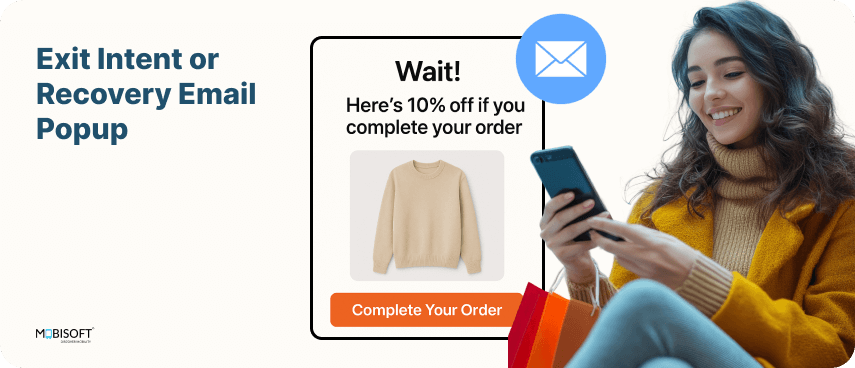
Let’s look at tools that support these strategies and make shopping cart abandonment recovery simpler.
A/B Testing to Improve Shopping Cart Performance
- Tools like Google Optimize or VWO let you test variations in your checkout flow, CTAs, form fields, etc.
- Try changing button colors, labels like “Buy Now” vs. “Proceed to Checkout,” or even where discount messages appear.
- These insights help you fine-tune what works best, based on actual data, not guesswork.
AI-Powered Chatbots for Checkout Optimization
- Smart chatbots (like Tidio, Zoko, or WhatsApp bots) can guide customers in real-time.
- They answer questions about returns, shipping costs, or product info instantly, reducing friction and improving confidence.
- Plus, they’re available 24/7, helping even when you’re offline.
To dive deeper into personalization, explore how AI in ecommerce enhances product recommendations and customer engagement.
Use Abandoned Cart Recovery Emails Strategically
Cart recovery emails still work, especially when done right.
- Tools like Mailchimp, Klaviyo, or native plugins let you automate this easily.
- Include the product image, a quick note like “Still thinking it over?”, and maybe a small discount or free shipping.
- Timing matters: send one after 1 hour, and another within 24–48 hours.
Remarketing Ads to Re-Engage Shopping Cart Users
Use Facebook Pixel or Google Ads remarketing to re-engage shoppers who dropped off mid-checkout.
- Show them visual ads of the items they almost bought.
- Even a ₹500–₹1000 budget can bring results by keeping your brand top-of-mind.
These tools don’t require a dedicated tech team; many offer drag-and-drop interfaces or simple plugins.
Boosting Business Growth by Reducing Shopping Cart Abandonment
Lowering shopping cart abandonment is a strong engine for long-term company expansion, not only for avoiding lost income.
Increased Sales and Revenue
Every finished order directly impacts your bottom line. Small changes like cutting cart abandonment rates by just 5 to 10% can lead to significant revenue increases.
Visualize now increasing order completions by 20 to 25%. That's not just a shopping cart sales comeback; it's a large-scale expansion.
Improved Customer Satisfaction
A slick, simple checkout experience leaves an indelible impact. Customers are far more likely to return and bring their friends when they don't encounter problems, delays, or unnecessary stages.
Perfect shopping cart software transactions build devoted customers who shop more often and disseminate the news.
Enhanced Brand Reputation
Your ecommerce shopping cart process captures your brand. It establishes trust when it is quick, safe, and reliable.
Not only will a client who believes your platform come back, but also feel secure suggesting you to others. That sort of reputation is invaluable in today’s competitive digital shopping cart abandonment economy.
Success Stories from Real World Businesses
Many global businesses, whether niche craft stores in Europe or regional delivery apps in Southeast Asia, have seen significant improvements in abandoned cart recovery after implementing simplified checkout, mobile shopping cart optimization, and localized payment options for ecommerce.
Minor changes like adding guest checkout benefits or offering local wallet integrations have led to up to 25% boosts in completed orders.
See our quick commerce case study to understand how simplified checkout solutions drive real-world business growth.
Conclusion: Turn Abandoned Shopping Carts into Loyal Customers
Although it presents great potential, every e-commerce company struggles with shopping cart abandonment. Correct methods can transform those abandoned shopping carts into faithful consumers, conversions, and regular income.
You don't need pricey equipment or a whole platform makeover. Effective changes include streamlining checkout, promoting multiple payment options, and leveraging smart technologies like abandoned cart recovery emails, chatbots, and exit intent popups to significantly change things.
We are here to assist you in achieving growth with unique strategies, checkout optimization tips, and ecommerce audits customized for your market, whether you are a developing company or a worldwide online store.
- Download our free guide to ecommerce shopping cart optimization if you want rapid wins.
- Require specialized advice? Reserve a no-obligation Discovery Call.
- Looking for a permanent partner? Let us connect and grow together.
Let us transform forsaken online shopping carts into faithful consumers, working together.
We are here to assist you in achieving growth with unique strategies, checkout optimization tips. Explore our ecommerce development services designed to align with your business goals.


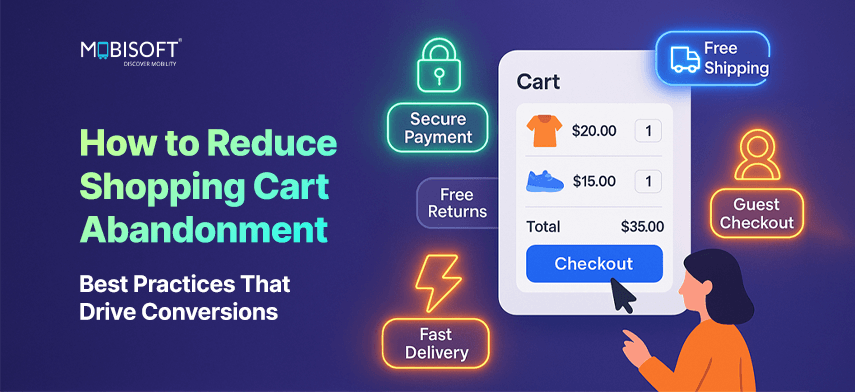


 July 11, 2025
July 11, 2025


